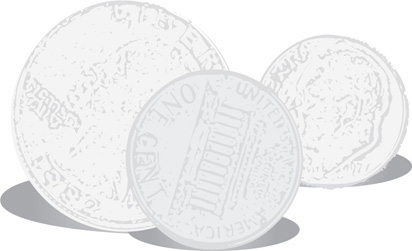Chapter 3
Understanding Quicken Mobile
In This Chapter:
• Appreciating mobile
• About your mobile companion
• Understanding your Quicken ID
• Getting started from your desktop
• Setting alerts
• Getting started on your mobile device
• Working with the Quicken Mobile Overview page
In today’s hectic world, you are not always at your desktop computer when you need financial information. With the Quicken Mobile app you can check your credit card balance using your iPad while at work or glance at your smart phone to see if a check has cleared while you’re at the gym. This chapter explains how to get started with the Quicken Mobile app and discusses its features.
 Understand Mobile Applications
Understand Mobile Applications
A mobile application (or app) is a small program especially designed to run on smart phones, tablet computers, or other mobile devices. If you have ever downloaded a game onto your cell phone, your favorite tune to your MP3 player, an e-book from the library to your e-book reader, or a map to your tablet computer the last time you took a trip, you have used a mobile app. Many apps, like the Quicken Mobile app, are free, and others are available for a small price. Of the price for the apps sold to the user, a percentage of the cost goes to the distributor (such as iTunes) and the rest goes to the person or company that created the app.
Appreciating Mobile
We hear the words “cloud” and “mobile app” everywhere in our world today: in advertisements, news programs, even schools. Just what is the cloud and how is it used? The term, whose original use is obscure, refers to storing programs and data at a location other than the owners’ (or users’) physical location and allowing users to access that information via the Internet.
If you have ever viewed a YouTube video, have a Gmail account, or used a website to share family photos, you’ve accessed the “cloud.” The reality is that much of what we do each day on the Internet is done in the cloud. There is even an e-book version of this book downloadable from the cloud!
 Meet Quicken’s Mobile App
Meet Quicken’s Mobile App
Quicken’s Mobile app is designed for Quicken users who want the ability to access their information from anywhere with an Internet connection. Are you required to use the Quicken Mobile app? No. Many Quicken users find the desktop program has all the features they need. However, by installing and using the free Quicken Mobile app on your Android or Apple device, you can keep up with any of your spending accounts—checking, savings, and credit cards—no matter where you may be.
About Your Mobile Companion
Quicken’s Mobile app is available only for those who have purchased Quicken and installed the program on their laptop or desktop computer. It is used as an add-on to your Quicken program, not as a stand-alone product. Only after you have created your Quicken ID and set up your accounts, as discussed in Chapter 1, can you start using Quicken’s Mobile app.
Some Quicken users never use this tool. Others find it invaluable. It is up to you to decide. So what are the requirements for using Quicken’s Mobile app?
• You must have either an Apple (iOS) or Android mobile device such as a tablet or smart phone with the ability to connect to the Internet.
• You must have set up your accounts on your desktop or laptop computer.
• You must have the Quicken ID you created when you first installed Quicken.

Depending on your device, screens may look a bit different than the illustrations shown in this chapter.
 Beginning with Quicken’s Mobile App
Beginning with Quicken’s Mobile App
If you are excited about the ability to see your financial information from any location with an Internet connection, it’s time to get started. When you first installed Quicken on your computer, you created your Quicken ID. At the time, you may have chosen not to use mobile, as using the mobile application is strictly optional, as seen in Figure 3-1. However, you can decide later to access your information from the Quicken Mobile app. This section explains both the advantages of using the app and how to set it up from your desktop.
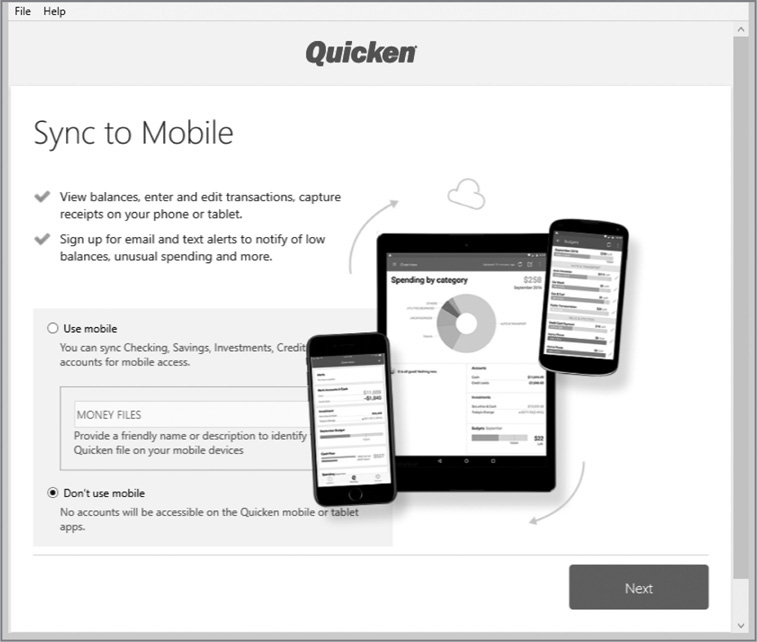
Figure 3-1 · When you first set up your Quicken desktop account, you are given the choice to use the Quicken Mobile app.
Understanding Your Quicken ID
Quicken uses your Quicken ID to enable your access to your financial information from anywhere using either your smart phone or a tablet. Having that capability can make your financial life easier and eliminate the “oh my gosh” feeling that you have forgotten to send an important payment. This ID is used by Quicken to display alerts on the Quicken Mobile Overview page in the Mobile & Alerts section on your desktop. You can also opt to receive e-mail alerts regarding the accounts you choose to access on your mobile device. It is very useful to know that your salary check was, indeed, deposited yesterday or that a new charge was placed on your credit card.

The ability to monitor your credit card accounts may be one of the most useful features of the Quicken Mobile app. The moment you see a charge that you have not made, you can call your financial institution to report the error.
Getting Started from Your Desktop
If you did not choose to use the Mobile app when you first installed Quicken, you can do so at any time. From your desktop, select the Mobile & Alerts tab. The Mobile Overview screen appears. You will see a small window, seen next, that is one of a series that explains how you can use the Quicken Mobile app. You can cycle through these windows, using the right-facing arrow or close them with the X at the upper right of the first window. To learn even more, select the Watch A Video link at the upper right of the screen. This is a link to a YouTube video that gives an overview of the Quicken Mobile app.


Depending on your device, you may not see the small window the first time you try. Often it will take a second opening of Quicken to see this displayed.
If you close the small windows, you see the Quicken Mobile Overview screen as seen in Figure 3-2. You see the steps outlined on the screen. First, you will enable the accounts you want to access on your mobile device. Next, you tell Quicken how you want to be notified of any changes to your enabled accounts. Once you select Get Started, the Add Account Settings dialog appears, as shown in Figure 3-3.

Figure 3-2 · Setting up your Quicken Mobile app is easy from your Windows desktop.
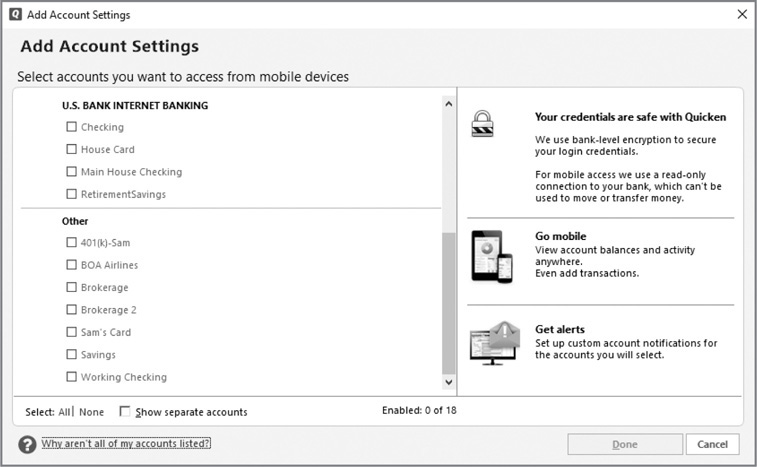
Figure 3-3 · You can choose to use the Quicken Mobile app to access all of your accounts, some of your accounts, or none of your accounts.
Select the accounts you want to see on your mobile devices from the list of available accounts. You can choose both banking and investment accounts.
1. Enter the online banking password for each account you want to synchronize. Although it says to enter your account password, you are actually entering the password for your financial institution’s site, where you may have multiple accounts.
2. Click Done to complete the process.

You may also see a message in your e-mail from Quicken saying you have activated alerts.
You see a message that your accounts are syncing with Quicken Cloud. When the information has been synchronized, a message appears that your sync is complete as seen here. (This message appears only if you are setting up mobile access separately from adding accounts.) Click Done to close the message.

There is a difference between adding or changing accounts to sync and just syncing without making any account selection changes. When you add or change the accounts to be synced, the message while syncing will say “Updating accounts” and when done syncing the message will be “Done,” with instructions on how to get the Mobile app from the app store on the first account sync and no “Done” message on subsequent account updates. When you sync, the message will be “Syncing accounts” and the “Done” message will be “Cloud Sync Complete.”

Work with the Quicken Mobile Overview Screen
The Quicken Mobile screen, seen in Figure 3-4, appears. Note that it shows only the accounts that you have chosen to access from your mobile device. There are other useful links in this screen, as discussed next.
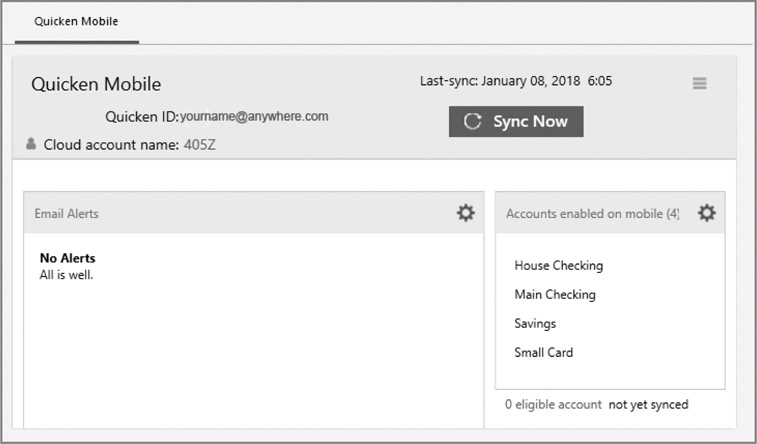
Figure 3-4 · The Quicken Mobile screen gives you information about your synced accounts.
Change Your Mobile Preferences Note the small square to the right of the date of the last sync. This opens a link to Quicken Preferences. Click Preferences to open the Quicken ID, Mobile & Alerts section of Quicken Preferences. Your current Quicken ID Profile appears at the top of the Preferences dialog. With the options in the Settings section, you can change the accounts you want to sync as well as your Alert settings. See “Setting Alerts” later in this chapter for more information about alerts.

The small square—a stack of three horizontal lines—can also be referred to as a hamburger or burger button. Wikipedia also mentions hotdog, pancake, tribar (or triple bar), double Oreo, or options button. I like burger button, but options button might be more familiar to you.
Choose Cloud Accounts in the Preferences dialog to create a nickname or description to identify this file on your mobile device. This can be different than the filename if you choose.
Click Cancel to close the Preferences dialog without saving changes. To save changes, click OK instead. Clicking either OK or Cancel closes the Preferences dialog and returns you to the Quicken Mobile Overview screen.
Sync Now Use the Sync Now link at the upper right of the Quicken Mobile Overview screen to sync your accounts with Quicken. The message that appears shows that your accounts are being synced with the Quicken Cloud.
When the operation has completed, the Cloud Sync Complete appears. Click OK to dismiss the dialog and return to the Quicken Mobile Overview screen. Note you can select the Don’t Show This Again check box if you do not want to see the Cloud Sync Complete message each time your data is synced.

Even though the Mobile screen does not include the word “overview,” I’m using it throughout as that’s how it is mentioned in Quicken Help. Of course, the Help screen also mentions items that are not necessarily available at the time this is being written.
Edit Account Settings Click the small gear icon next to the Accounts Enabled on Mobile indicator to see the link to Account Settings. The Edit Account Settings dialog appears. You may add or delete accounts to access via your mobile device in this screen, as seen in Figure 3-5. After you are done making changes, click the Update Accounts button to let Quicken know of the changes. Otherwise, click the Cancel button to close.

Figure 3-5 · You can change the items to be accessed by your mobile device at any time.
Setting Alerts
One of the great reasons to use Quicken’s Mobile app is its ability to tell you about various financial happenings, even when you are not at home in front of your desktop computer. To let Quicken know the information you would like to see, from anywhere in Quicken, click the Mobile & Alerts tab. At the Quicken Mobile Overview screen, select the small gear icon in the Email Alerts section to open the Alerts Settings link, which opens the Edit Alerts Settings dialog, as seen in Figure 3-6.
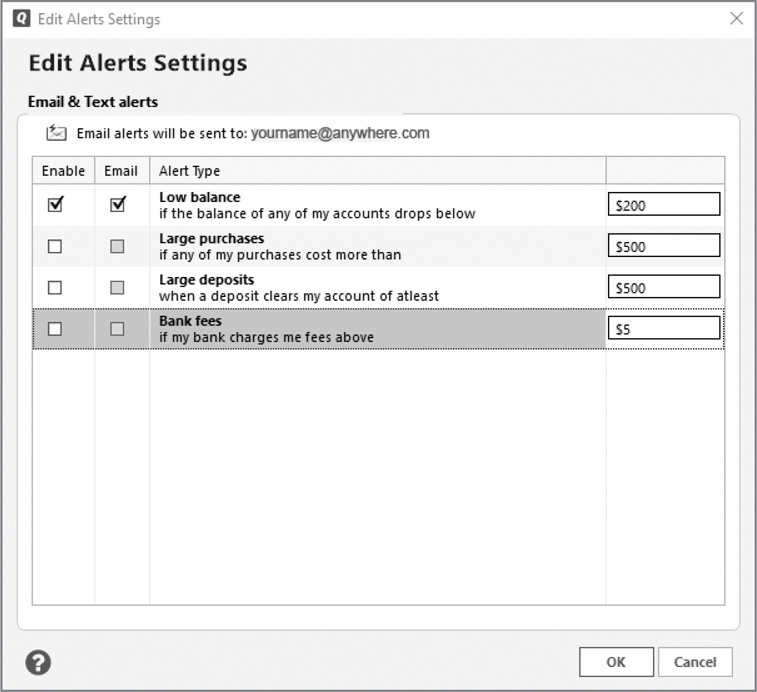
Figure 3-6 · Use the Edit Alerts Settings dialog to show alerts on the Quicken Mobile Overview screen as well as receive e-mails about those alerts.
Each of the sections lets you choose how you want to receive alerts about your accounts. You have the option to enable alerts that appear in the Mobile & Alerts Overview section as well opting to receive e-mails of the alerts you have enabled. Note that there are two types of alerts: App Alerts and Email Alerts.
Email and Text Alerts
In this section you can add a secondary e-mail address for Quicken to use for alerts. Your Quicken ID e-mail address is the primary e-mail by default.
What Type of Alerts Do You Want to Receive?
The Edit Alerts Settings dialog is where you tell Quicken both the information you want to see and how you want it delivered. You can choose to have each item delivered via a message on the Quicken Mobile screen. You can opt to have these alert messages delivered by e-mail as well. Click the check box for each type of alert to tell Quicken how to deliver the alert.
• Low Balance This selection alerts you to low balances in any of your synced accounts. You can choose to be warned of any balances below $0, $50, $100, $200, $500, $1,000, or $2,000.
• Large Purchases By choosing this option you are advised of any purchases that are over your designated amount that appear on any of your accounts. You can choose to be told about purchases that are over by $200, $500, $1,000, $2,000, or $5,000.
• Large Deposits Expecting those lottery winnings any day? This option lets you know when a deposit over the amount you designate is posted to your account. You can choose from $200, $500, $1,000, $2,000, or $5,000.
• Bank Fees If any of the banks you have enabled for mobile access charges a fee above the amount you specify, choosing this option will alert you to that fact. The drop-down list offers five choices: $0, $1, $5, $10, and $50.
After you have made all of your choices, click OK to continue. You will see that your alert settings are being updated. When that message disappears, you are back at the Mobile & Alerts tab screen.

At the time this is being written, the Help Screen has some discrepancies from your mobile screen.
 Using Your Mobile Device
Using Your Mobile Device
After you have completed your settings on your desktop, you are ready to begin using the information on your mobile device. The first step is to download the free Quicken Mobile app and install it on your mobile device. You can obtain the app from the sources shown next or visit the Quicken.com website for more details. If your device is an iPhone, you must have iOS 8 to install the app.
• The Amazon App Store
• The Apple App Store
• Google Play
Getting Started on Your Mobile Device
Once your app is installed, go to your apps and you’ll see the Quicken icon on your device. Tap the app to begin working with your Quicken Mobile app. On the iPad and Android phone, the icon is a big white Q on a red background with a Quicken label, as seen next.
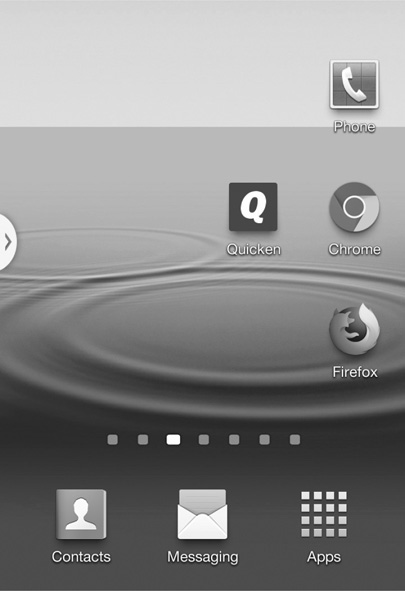

If you find the Quicken Mobile app in one of the app stores, remember, as this is a companion to Quicken for Windows, you cannot use the app without Quicken for Windows installed on a desktop.
To ensure your accounts are available on your mobile device, set up your mobile accounts using your desktop Quicken program. Once you’ve selected the Quicken app on your device, you’ll see the Let’s Get Started screen. On the iPhone, the screen is not labeled Let’s Get Started. It has Quicken at the top and two buttons: Get Started and Sign In.

Because mobile operating systems differ, you may find that some of the illustrations shown in this chapter are different or not available on your mobile device.
The Get Started Message
When you tap the Quicken Mobile app icon it may be offering two choices, as seen next. Depending on the device you are using, you may see the screen shown here. This welcome screen is out of date, but has been seen on both Android and iPhones. If you choose the Get Started option, you might be prompted to buy and install the Quicken program, register, and set up through the Mobile & Alerts tab before using the program. Then, you can sign in with your Quicken ID. If you have already done those steps (purchasing, buying, and registering Quicken), just click the Sign In button.
When you tap Sign In to enter your Quicken ID, the sign-in dialog appears. Enter your Quicken ID to continue.
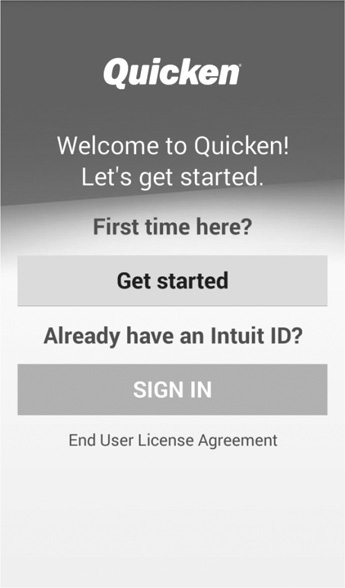

If you see a message that your sign-in failed and you are sure you entered the correct e-mail address, try re-entering your password. Depending on your mobile device, it is very easy to type incorrectly.
Working with the Quicken Mobile Overview Page
After you have correctly entered your Quicken ID, the Home or Overview page of the Quicken Mobile app appears, as seen in Figure 3-7. Each section enables you to see more information as discussed next. You may have to enter a six-digit code that will be sent to you either via text message or e-mail. Also, if you have more than one Quicken file, you may have to make a selection after you enter your Quicken ID credentials.

Figure 3-7 · As seen on an Android smart phone, the Overview screen in your Mobile app shows information about your accounts.
Since each device and operating system differ, what you see on your device may look different. For example, on an iPhone, you may be prompted with an offer to set a passcode before you see an Updates screen.
Recognize the Quicken Mobile App Tools
Because each mobile device varies, so will your display. If you are using a tablet, small icons appear. The location of the icons depends on your device.
If you use the Mobile app on a smart phone, you may have to swipe through screens or tap an action button. On some devices you see small icons.
• Home On some screens you will see a small “house” icon that will take you to the Home page.
• Search The small magnifying glass opens the Search tool dialog. At the bottom of this screen is a keyboard (not shown).With this dialog you can type the name of a payee, a category, or, if you use them, a tag name. Learn more about tags in Chapter 4.
Depending on your device, you may only see the Search field once you have opened an account. The search now will use the text you enter in the Search field to search payee, category, tag, memo, amount, and check number fields. You don’t have to enter the whole word—the search works even for a partial word or a partial amount. For example, searching using “tax” will find “Federal Tax” in a category, “Joe’s Taxi Service” in a payee, or “tax” in a memo. This is similar to how the register and All Transaction Search field works in the desktop program.
• Add Transaction This tool opens a link to add a new transaction as shown here. To work with this dialog, see “Work with the Transaction Tool” next in this chapter. On some devices, including the iPhone, the Add Transaction icon is a plus sign.

• Update This tool updates your accounts.
Work with the Transaction Tool When you choose to add a transaction, depending on your device, you may see more than one screen. Shown here, the first screen shows a number pad from which you can enter the amount of your transaction. By default, the transaction is classified as an expense. If this is incorrect, tap that field to change the transaction type, payment type, and account. From this dialog you can select
• Whether this transaction is an income or an expense item.
• Whether the transaction is cash, credit card, or a check.
• The account for this transaction. If the appropriate account for this transaction does not show, tap the field to open the list of your accounts.
• Enter the amount of this transaction. Quicken automatically places a two-place decimal point.
• Tap the Choose A Payee field to open the Choose Payee dialog. (On the iPhone, the field shows “Finding Your Location,” then changes to “Choose A Payee,” presumably when the location is found.)
• Choose a payee from the list if it is available. On some devices you may not see any payees until you start typing the first letter of a payee name.
–Or–
• Tap the Enter Payee Name field to open a keyboard with which you can type a new payee name. After you have typed the name, you will see Create “nnnn” (with nnnn being the payee name you just typed). Tap Create “nnnn” to save the payee name. Depending on your device, you may not see the “Enter Payee Name” text, just the empty field.

• If the account from which this transaction occurs differs from what appears and you have not changed it earlier, select that field and choose the appropriate account.
• Click Next to open a screen, as shown here, from which you can change the name of the payee, enter the category, the date, tags, and a memo if needed.

• Tap the Category field to select the appropriate category for this transaction.
• Enter the date of this transaction. Today’s date will appear but you can change it.
• Enter a tag or a memo if you choose. Depending on your device, you may see a map of the location of the payee.
• Depending on your device, click Save and you are returned to the Quicken Overview screen. On the iPhone, you tap Done to save your completed transaction.
The Overview Screen on Your Device
As seen in the next illustration, you may have links that appear as vertical dots, or horizontal lines, or even a small gear icon. The illustration is from an Android phone showing three horizontal lines and three vertical dots. Each set of lines or dots is a link to additional items. The equivalent on the iPhone is the button bar on the bottom of the overview screen; the buttons are Updates, Overview, and Settings. Note that in the illustration there are two circular arrows that act as a “refresh” button. There are no equivalent items in the iPhone; instead you refresh by swiping down and releasing.
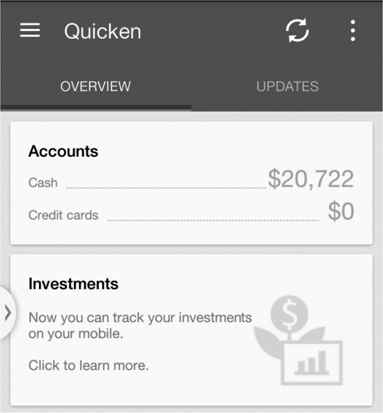
Depending on your device, selecting these links may open a menu such as the one seen next. Remember, every device shows items in a slightly different manner. Note here that the Budgets category shown on the example is not yet available as of the date we are writing this chapter.
Each device varies with the options discussed next:

• Accounts This dialog displays the accounts with which you have selected to work. Each account shows the name of the financial institution, the account type and name, and the balance that was current as of your last download. You may also see the last update date and time.
• Security If you share your device with someone else, you can protect your financial information by using the Quicken Passcode feature. Tap the link to bring up the Passcode dialog. Use the keyboard to enter a four-digit passcode. Re-enter the code, and after you have done so, you are returned to the Settings dialog.
• Logout Tap here to log out of your Quicken Mobile app. Get into the habit of signing out each time you use Quicken Mobile, to ensure your financial information is no longer “live’ on that device. Depending on your device, the message may be Sign Out or Log Out.
• About Quicken This section tells you what version of the Quicken Mobile app you are using and other information about the program.
• Help This option opens the Help dialog. Its label may vary, depending on your device. In the iPhone, there is no About Quicken and no Help listed; instead, there is a Help And Legal entry, which contains similar information.
To return to the Overview, tap the small Quicken icon at the upper left of your screen or the three horizontal bars at the upper left of your smart phone screen. On the iPhone, to return to Overview from Settings, click the Overview icon at the bottom center of the screen.
The Spending By Category Snapshot
In most devices, the top of your Overview page shows a colorful chart with the categorized and uncategorized expenses for the current month, as shown earlier in Figure 3-7. At the upper part of the screen is the total amount you have spent for the current month. On other devices, such as a smart phone, you may see a bar chart.
The iPhone shows a colorful donut chart displaying spending for the month on the Overview. For the first few days of each month, the Spending By Category chart will show the previous month’s spending. This is because it takes a few days to accumulate enough transactions to trend the new month’s spending.

On some smart phones or other devices, you might tap in the Earned And Spent section to see this detail. When you tap that option, you can review further detail by tapping Category or Payee and then tapping the category or payee you wish to review.
Tap any of the category sections in the Category donut to open a larger screen from which you can look at the totals for that category and any others.

On the iPhone, tapping any segment of the donut opens the Spending screen, displaying the top spending category by amount. Then tapping on any segment in the donut displays the amount of spending for that segment. You can then see the transaction detail by tapping the nn transactions link below the donut.
From this screen you can
• See the total spent in that category in the current month. To see the amounts spent in a previous month, tap the name of the month at the bottom of the window. Use the calendar icon at the bottom right of your screen to open the View Time Range dialog from which you can view the amounts you spent in this category for This Month, Last Month, or This Year. Your device may not have this capability.
• Tap on any other category in the donut to see the detail for that category.
• Tap the Transactions link to see what transactions are included in this total.
• Tap the See Details link to see additional information about the expenditures.
• Tap the Overview icon to return to the Overview page.
More Spending Reports
If you slide the Spending By Category snapshot seen on tablets, you will see two more snapshots. On the iPhone, you can see Spending Over Time and Net Income Over Time by tapping the All Trends link below the Spending donut in the Overview screen.
Spending Over Time This snapshot displays your total spending for the last six months as a columnar graph. Tap any column to enlarge the graph. When you select a month, the total spending for the month (or month to date if you are working with the current month) displays at the bottom of the graph. The graph may vary, depending on how much data you have entered into Quicken.

Not all mobile devices contain the Spending Over Time graph.
Tap Transactions to see each transaction for the month. Tap See Details to open a Spending By Category snapshot. Your mobile device may not have these capabilities.
Net Income Over Time When using your tablet, slide once again to see the Net Income Over Time snapshot. The information again shows in columnar graph form. Select any month to see both the income and expenses for that month.

Your smart phone may not have a Net Income Over Time snapshot.

There are three small circles at the bottom right of the Spending By Category snapshot. Tap each circle to cycle through the main Spending By Category, Spending Over Time, and Net Income Over Time snapshots. You can also swipe to see the other snapshots.
Transaction Detail Window
When you choose a specific transaction, the Transaction Detail window allows you to make changes, view information, and split the categories for the transaction. Depending on your device, there are several ways to access a specific transaction. One way is to click Accounts and select the account in which the transaction is posted.
Split a Downloaded Transaction Tap on a transaction. In the Transaction Detail window, tap the Split button to open the Split dialog. (On an iPhone, the Split button is only shown on already entered transactions. You cannot split a transaction while you are entering it.)
• To add a new category, tap Add or the white cross within the green circle. A new category line appears along with a calculator. Tap the right-facing arrow in the category field to choose from the list of categories.
• Tap the amount field for that category and enter the numbers from the calculator. You do not need to enter the decimal point, as Quicken enters it automatically. For example, tapping 3465 will show as 34.65.
• Repeat the process for each new category. As you enter new amounts, the original amount adjusts to reflect your entries. If you enter a number that would make the total less than zero, you will see a warning that the amount you are entering is too large.
• Tap the white minus sign inside the red circle by any category, and a small Delete message appears in the amount field. Press the message to delete that category.
• Tap Save when you have completed your changes, or Cancel if you decide you don’t want to split the transaction. Your transaction appears. After you have reviewed your transaction, tap the Back button at the upper left of the screen to return to the previous screen. Repeat the process until you are back at the Overview page.

In some mobile devices, you may have to tap the <Your Account Name> button to return to the transaction listing for the account.
Use the Snap and Store Feature in Quicken Mobile
Each time you add or edit a transaction in your Quicken Mobile app, you can use the Snap and Store feature if your device can take pictures. Simply find the transaction to which you want to add a picture and tap that transaction.
Tap the camera icon, which is usually a camera with a dotted line box around it, to take the picture. You may be prompted to select Allow or OK to let Quicken Mobile have access to your device’s camera.
To ensure the Quicken Mobile app can access your device’s camera:
1. Go to Settings on your device.
2. Find the Apps section or list and choose Quicken.
a. On an Android device, tap Permissions and turn Camera, Location And Storage on.
b. On an Apple device, find Camera on the list and set it to the On position.
